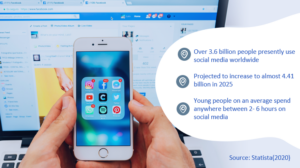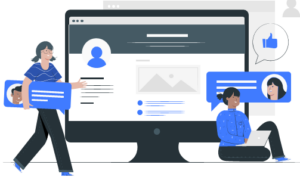Today, digital spaces are an important and inescapable aspect of our social and personal lives. In 2005, only 5% of Americans reported using one or more social media platforms; by 2019, this number had risen to 72% (Pew Research Center, 2021). Furthermore, young people on an average spend between 2-6 hours on social media sites such as Facebook, Instagram, Snapchat, TikTok and YouTube (Statista, 2022).

Given the amount of time young people are spending on social media and how intertwined it is with their existence, connecting concepts taught in the classroom with what is happening on social media can potentially lead to enhanced learning outcomes. Research suggests that learning engagement is key to achieve superior academic outcomes (Freeman et al, 2014). When students perceive course content to be relevant and valuable to their personal and professional lives, they feel motivated to learn. Furthermore, understanding the rapid growth in engagement on social media platforms and their impacts on human behavior can be sites of inquiry themselves.
Most instructors require students to abstain from using social media in the classroom. The insights offered in this resource help us reimagine alternatives to surveillance, by mindfully integrating social media use as part of the lesson plan. This can create a classroom experience that is more “natural” for young people, and also open possibilities for conversations around thoughtful and meaningful social media engagement, and what it means for us.
Experiences shared on social media are “naturally occurring” i.e. they are not generated for the purposes of research. Unlike information gathered in a laboratory or through self report questionnaires, where there is a possibility that the information we gather can be artificial or biased, social media Therefore, it has potential to offer us unique insights about behavior in everyday life rather than data generated in artificial settings
Social media platforms offer a relatively economical, quick, and targeted way of collecting data, especially as compared to some other sources, e.g. polls, surveys, demographic and economic data. This data can useful for class projects and to help students analyze social phenomenon as they are unfolding in real time.

Rationale for this project
Designing class projects or assignments that draw on social media can be daunting for instructors in the social sciences for several reasons. First, many of us may lack the necessary resources to pull off such a project such as, access to a dedicated computer lab or proprietary software for data harvesting and analysis, and/or technical assistance to pull off these projects. Second, social media research is often perceived interchangeably with Big Data and computational methods. A related assumption is that instructors and students need to be well versed in coding in programming languages/software such as R or Python to undertake such projects. Third, it involves gaining familiarity with the rapidly evolving landscape of digital technology and social media platforms. The demands of an increasingly precarious, neoliberal academia are exhausting. The additional task of tuning into popular online culture, trending hashtags, or even the basic skills of navigating a new platform can feel overwhelming and an additional “burden”. This is especially for those of us (including myself) who do not identify as digital natives.
To address some of the concerns outlined above, this website draws on Open Educational Resources that require no previous familiarity with computer programming and need minimal investment in terms of learning new skills. Open Educational Resources (OER) are learning, teaching and research materials that are available in the public domain or are under copyright that have been released under an open license, that permit no-cost access, re-use, re-purpose, adaptation and redistribution by others (UNESCO). The OERCommons is a public digital library of open educational resources and a great database to begin exploring the world of OER.
For analyzing social media data, the website suggests methods that require little use of programming languages. These include primarily inductive and qualitative, approaches such as thematic analysis, grounded coding, and use of descriptive statistics. (For those curious to learn more about coding, there are a host of OER resources available online.)
References
Freeman, S., Eddy, S. L., McDonough, M., Smith, M. K., Okoroafor, N., Jordt, H., & Wenderoth, M. P. (2014). Active learning increases student performance in science, engineering, and mathematics. Proceedings of the national academy of sciences, 111(23), 8410-8415.
Pew Research Center (2021). Social Media Factsheet.https://www.pewresearch.org/internet/fact-sheet/social-media/
Statista Research Department (2022). Daily time spent on social networking by internet users worldwide from 2012 to 2022. https://www.statista.com/statistics/433871/daily-social-media-usage-worldwide/

